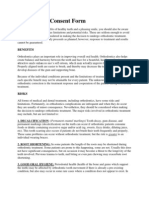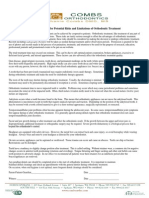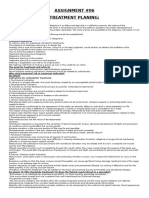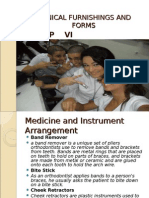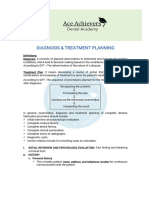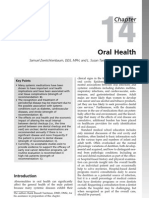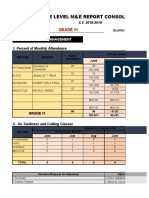Yes - No
Yes - No
Uploaded by
drakashverma7Copyright:
Available Formats
Yes - No
Yes - No
Uploaded by
drakashverma7Original Title
Copyright
Available Formats
Share this document
Did you find this document useful?
Is this content inappropriate?
Copyright:
Available Formats
Yes - No
Yes - No
Uploaded by
drakashverma7Copyright:
Available Formats
PATIENT CONSENT FORM TO BEGIN ORTHODONTIC TREATMENT
As a general rule, orthodontic treatment is an elective procedure and excellent results can be achieved with informed and cooperative patients.
While recognizing the benefits of a pleasing smile and healthy teeth, you should also be aware that orthodontic treatment, like any treatment of
the body, has some inherent risks and limitations.
General Patient Cooperation: Patient responsibilities are: brushing and flossing on a daily basis, being on time for all appointments, adhering to the
food list restrictions, wearing removable appliances as required, and visiting your general dentist for your regular six month cleanings. When
patients follow the instructions that are given, this will prevent damage to the teeth and surrounding tissues. These instructions will also help keep
initial treatment time accurate.
Oral hygiene: Tooth decay, gum disease, or enamel decalcification (permanent white stains on teeth caused by early stages of decay process) can
occur if patients do not brush their teeth properly during treatment period. Excellent oral hygiene and plaque removal is very important. Sugar
snacks and sugary drinks between meals should be reduced as much as possible.
Treatment time: Your initial estimation of orthodontic treatment time is based on average treatment times of very large patient populations. Each
patient is unique and their response to treatment may pose slightly different results that will change the original length of care. The total time for
treatment can be altered or delayed beyond your original estimate. The lack of facial growth or poorly directed facial growth; poor elastic wear;
repeated broken appliances and missed appointments are all examples of important factors that could lengthen treatment time and affect the
quality of the final result.
Growth patterns: Occasionally a person who has shown normal growth in average proportions may not always continue to do so. If facial growth
becomes disproportionate during treatment, the jaw relationship can be affected and original treatment objectives may have to be compromised
or altered. Skeletal growth disharmony is a biological process beyond the orthodontist’s control. Some orthodontic patients will require oral
surgery to obtain a reasonable treatment result if skeletal disharmony exists.
TMJ: There is a risk that problems may occur in the tempromandibular joint (TMJ). Although this is rare, it is a possibility during treatment. Tooth
alignment or bite corrections can sometime improve tooth related causes of TMJ pain, but this is not true in all cases because there are many other
causes of TMJ dysfunction. Please inform us if you have a history of TMJ pain, are currently experiencing TMJ pain or develop symptoms during
treatment.
Unusual occurrences: Swallowed appliances, chipped teeth, dislodged restorations and allergies to latex or nickel rarely occur but are possible
during orthodontic treatment. Please inform us if anything unusual occurs or develops during your treatment.
Root Resorption: In some cases, the ends of the roots of teeth are shortened during treatment. Under healthy circumstances the shortened roots
are no disadvantage. However, in the event of gum disease later in life, the root resorption may reduce the longevity of the affected teeth. It
should be noted that not all root resorption arises from orthodontic treatment. Trauma, impaction, genetics, endocrine disorders, and unknown
reasons can also cause root resorption.
Impacted teeth: Some teeth do not erupt normally on their own and are referred to as being impacted. In attempting to move these impacted
teeth orthodontically, various problems are sometimes encountered which may lead to periodontal problems, relapse, or potential tooth loss.
Some impacted teeth may be fused to the jaw bone (ankylosed) and are unable to be moved.
Post treatment tooth movement (Relapse): Teeth always have a tendency to return to their original position after orthodontic treatment. Severely
rotated teeth have a higher tendency to relapse and this is most commonly seen in the lower front teeth. Retainers are placed or provided to
minimize this relapse from occurring. Your full cooperation in wearing these appliances is vital to long term success. To prevent relapse of your
teeth you should always remember to wear retainers “night time for lifetime!”
Special Needs Cases: Appointments must be in the morning and parent/patient is responsible for those accommodations.
I consent to the taking of photographs, study models, and x-rays needed for orthodontic records before, during, and after orthodontic treatment to
assist in the treatment planning and progress treatment objectives. If the orthodontic case proves to be of special scientific interest, the doctor
reserves the right to present or publish the records in scientific papers or presentations to the profession for educational purposes. I certify that I
have read or had read to me the contents of this form and do realize the risks and limitations involved, and I do consent to orthodontic treatment.
I also consent to the pictures that are being taken to be used on the orthodontic website and Facebook. Yes___ No___
Patient / Parent / Guardian Signature Witness Signature Date
You might also like
- Orthodontic Consent FormDocument3 pagesOrthodontic Consent FormDiana Suharti100% (1)
- Informed Consent-En FormsDocument2 pagesInformed Consent-En FormsBadrinath VedavyasaNo ratings yet
- Detailed Case History in C - DDocument54 pagesDetailed Case History in C - Dvahini niharika100% (8)
- Orthodontic Consent FormDocument12 pagesOrthodontic Consent FormMahardika Dyah KumalasariNo ratings yet
- Diagnosis and Treatment Planning For Partially Edentulous Patients11Document160 pagesDiagnosis and Treatment Planning For Partially Edentulous Patients11Rajsandeep Singh80% (5)
- Consent FormDocument2 pagesConsent FormRebin AliNo ratings yet
- Informed Consent ORTHO TestDocument4 pagesInformed Consent ORTHO TestjohnpurdellNo ratings yet
- Informed Consent FormDocument2 pagesInformed Consent Formapi-521417613No ratings yet
- FdpconsentorthoDocument2 pagesFdpconsentorthoAnshum GuptaNo ratings yet
- Presentation 1. Treatment Planning For The Immediate Denture 2. The Patient With Periodontal DiseaseDocument19 pagesPresentation 1. Treatment Planning For The Immediate Denture 2. The Patient With Periodontal DiseaseNika Permata DelaNo ratings yet
- Informed Consent FormDocument1 pageInformed Consent FormIrina ZumbreanuNo ratings yet
- Diagnosis and Treatment Planning of CD PatientsDocument95 pagesDiagnosis and Treatment Planning of CD PatientsAnjana ThomasNo ratings yet
- Adults OrthodotnicsDocument21 pagesAdults OrthodotnicsgadeenclinicsNo ratings yet
- 1 Examination, Diagnosis and Treatment PlanDocument61 pages1 Examination, Diagnosis and Treatment PlanradbusinessshakshoukiNo ratings yet
- OrthodonticsDocument18 pagesOrthodonticsPebrian Diki Prestya100% (1)
- Treatment Planing AssignmentDocument4 pagesTreatment Planing AssignmentHafsa ShahidNo ratings yet
- Group Vi: Clinical Furnishings and FormsDocument18 pagesGroup Vi: Clinical Furnishings and FormsJasmine Rey QuintoNo ratings yet
- Introduction To OrthodonticsDocument8 pagesIntroduction To OrthodonticsFarida Maria UlfaNo ratings yet
- Ngipin KoDocument5 pagesNgipin Kocarlsnerpios123No ratings yet
- Diagnosis and Treatment Plan of CDDocument12 pagesDiagnosis and Treatment Plan of CDIbrahim HashimiNo ratings yet
- D L, H R & L L: Periodontology 2000Document24 pagesD L, H R & L L: Periodontology 2000ph4nt0mgr100% (1)
- Dental Health EbookDocument15 pagesDental Health EbooktmetscherNo ratings yet
- case selectionDocument82 pagescase selectionaishwarya khareNo ratings yet
- Six Month Smiles Consent FormDocument3 pagesSix Month Smiles Consent Formabarbel1No ratings yet
- A Foundation For Beautiful Smiles For A LifetimeDocument2 pagesA Foundation For Beautiful Smiles For A LifetimeSWATINo ratings yet
- Dental AidDocument6 pagesDental AidCroitort530% (1)
- CD 1Document37 pagesCD 1Pushpal RoyNo ratings yet
- Complication of Orthodontic TreatmentDocument18 pagesComplication of Orthodontic Treatmentতৌহিদ তপু100% (2)
- Principles of OrthodonticsDocument75 pagesPrinciples of OrthodonticsMichael100% (1)
- Lec 6Document5 pagesLec 6Dr NisrinNo ratings yet
- Dental Care For A Child With Cleft Lip and PalateDocument2 pagesDental Care For A Child With Cleft Lip and PalateDorcas Abigail Vásquez BecerraNo ratings yet
- m71019 - Ingles I GuiasDocument8 pagesm71019 - Ingles I GuiasJennifer MezaNo ratings yet
- Problem in Complete Denture Treatment and Postinsertion DentureDocument35 pagesProblem in Complete Denture Treatment and Postinsertion DentureSorabh JainNo ratings yet
- Adjuncts To Mouth Reconstruction S.: Alexander Forster, New York, N. YDocument5 pagesAdjuncts To Mouth Reconstruction S.: Alexander Forster, New York, N. YAmar BhochhibhoyaNo ratings yet
- General DentistryDocument5 pagesGeneral DentistryVinnova Dental ThurgoonaNo ratings yet
- OrthodonticsDocument18 pagesOrthodonticsSorinNo ratings yet
- Lecture 13 - Extraction of ToothDocument46 pagesLecture 13 - Extraction of Toothvanesa AvramovaNo ratings yet
- Principles of OrthodonticsDocument75 pagesPrinciples of OrthodonticsIuliana DanilovNo ratings yet
- Dental SpecialitiesDocument21 pagesDental SpecialitiesRadu DraghiceanuNo ratings yet
- Dental Care For A Child With Cleft Lip and PalateDocument2 pagesDental Care For A Child With Cleft Lip and PalateKonstantina GlezakouNo ratings yet
- Research Paper On DentistryDocument8 pagesResearch Paper On Dentistryvrxhvexgf100% (1)
- Temporomandibular Joint Disorder ThesisDocument5 pagesTemporomandibular Joint Disorder Thesisheatherdionnemanchester100% (2)
- Informed Consent For The Orthodontic Patient: Consent of Orthodontic Treatment Provided by DR Mohammed AlmuzianDocument8 pagesInformed Consent For The Orthodontic Patient: Consent of Orthodontic Treatment Provided by DR Mohammed AlmuzianVidal Almanza AvilaNo ratings yet
- Oral Health: Samuel Zwetchkenbaum, DDS, MPH, and L. Susan Taichman, RDH, MPH, PHDDocument20 pagesOral Health: Samuel Zwetchkenbaum, DDS, MPH, and L. Susan Taichman, RDH, MPH, PHDwesamkhouriNo ratings yet
- m71019 - Ingles I Cuadernillo Guia Odontologia I - 2020Document8 pagesm71019 - Ingles I Cuadernillo Guia Odontologia I - 2020Jennifer MezaNo ratings yet
- Dental Specialities: Oral and Maxillofacial SurgeryDocument5 pagesDental Specialities: Oral and Maxillofacial SurgeryRadu DraghiceanuNo ratings yet
- ODTP - 4 Tooth Surface LossDocument7 pagesODTP - 4 Tooth Surface LossDr-Mohamed KandeelNo ratings yet
- Orthognathic Surgery Oral SurgeryDocument24 pagesOrthognathic Surgery Oral SurgeryFourthMolar.comNo ratings yet
- InglesDocument18 pagesInglesMaria Fernanda Ormeño GarciaNo ratings yet
- Dental Trauma GuidelinesDocument16 pagesDental Trauma GuidelinesKhushbu AggarwalNo ratings yet
- IADT Avulsion GuidelinesDocument9 pagesIADT Avulsion GuidelinesHashem Motahir Ali Al-ShamiriNo ratings yet
- Dentalconsent-Vizilite 0001Document4 pagesDentalconsent-Vizilite 0001Orlando GesualdoNo ratings yet
- Oral Surgery 14874Document4 pagesOral Surgery 14874StanislavNemtanuNo ratings yet
- Dental Assistant Research PaperDocument6 pagesDental Assistant Research Paperkiitoaulg100% (1)
- Trauma in DentistryDocument143 pagesTrauma in DentistrythegourmetgharNo ratings yet
- Diagnosis & Treatment Planning For Edentulous PatientDocument9 pagesDiagnosis & Treatment Planning For Edentulous PatientChhavi sharmaNo ratings yet
- Smile EnhancementDocument4 pagesSmile EnhancementRahulNo ratings yet
- Endo or ExoDocument3 pagesEndo or ExoVanindya Annisa ANo ratings yet
- Reading Ii - Unit 14Document6 pagesReading Ii - Unit 14Maryam GholizadehNo ratings yet
- Delerio, Janel O. Resistance Training ActivityDocument2 pagesDelerio, Janel O. Resistance Training ActivityCatNo ratings yet
- Applicability of Orem's Self-Care Theory To Practice - A Narrative ReviewDocument4 pagesApplicability of Orem's Self-Care Theory To Practice - A Narrative ReviewInternational Journal of Innovative Science and Research TechnologyNo ratings yet
- Essay indomie-RAFLYDocument6 pagesEssay indomie-RAFLY221 Rafly Rahmadafa SyabaniNo ratings yet
- Resume For SliDocument2 pagesResume For Sliapi-736992499No ratings yet
- EITK Unit-4 (Maharishi Shushruta)Document5 pagesEITK Unit-4 (Maharishi Shushruta)CHETANNo ratings yet
- 06 056 Tech Brief PCOSQ 1Document1 page06 056 Tech Brief PCOSQ 1Xoxa0% (1)
- Philips Heartstart XL - User ManualDocument234 pagesPhilips Heartstart XL - User ManualGuilherme Ferreira BeserraNo ratings yet
- Departemen Perhubungan Departemen Perhubungan Departemen Perhubungan Departemen PerhubunganDocument4 pagesDepartemen Perhubungan Departemen Perhubungan Departemen Perhubungan Departemen PerhubunganDaraNo ratings yet
- 1 Prefix MergedDocument24 pages1 Prefix MergedPaulaNo ratings yet
- Mirko Noordegraaf Public ManagementDocument16 pagesMirko Noordegraaf Public Management박예린No ratings yet
- Week 1 and Week 2Document11 pagesWeek 1 and Week 2Yeyen Elsya AfridelinsariNo ratings yet
- Pelvic Floor Distress Inventory Questionnaire - Short Form 20Document2 pagesPelvic Floor Distress Inventory Questionnaire - Short Form 20Dana Ysabelle Ibarra100% (1)
- Research Weebly FinalDocument12 pagesResearch Weebly Finalapi-535308345No ratings yet
- 2BDocument833 pages2BM7MD AshrafNo ratings yet
- Political Science III Assignment Sem 4Document10 pagesPolitical Science III Assignment Sem 4Deepu GuptaNo ratings yet
- Year in Search 2020 - GoogleDocument58 pagesYear in Search 2020 - Googlec.saibal9757No ratings yet
- FULLRESEARCHWORKONSTRESS EmmaDocument81 pagesFULLRESEARCHWORKONSTRESS EmmaCarmina BesarioNo ratings yet
- Acne VulgarisDocument27 pagesAcne VulgariswandaNo ratings yet
- Cunningham - Perceptions of Outcomes of Orthodontic Treatment in Adolescent Patients - A Qualitative StudyDocument21 pagesCunningham - Perceptions of Outcomes of Orthodontic Treatment in Adolescent Patients - A Qualitative StudyMilton david Rios serratoNo ratings yet
- Xii English PDF KVDocument147 pagesXii English PDF KVPrabal KrishnatreyNo ratings yet
- CARE OF CLIENTS WITH MALADAPTIVE PATTERNS OR BAHAVIOR - PrelimsDocument11 pagesCARE OF CLIENTS WITH MALADAPTIVE PATTERNS OR BAHAVIOR - PrelimsKrisha CafongtanNo ratings yet
- Health and Safety Management RequirementsDocument28 pagesHealth and Safety Management RequirementsjansherkakkandamNo ratings yet
- 1st Grade 11Document16 pages1st Grade 11Ardy PatawaranNo ratings yet
- English Drama ScriptDocument4 pagesEnglish Drama ScriptLestariNo ratings yet
- Preschooler G&DDocument5 pagesPreschooler G&DABISHAK RAVIKUMARNo ratings yet
- Strategic Human Resource ManagementDocument66 pagesStrategic Human Resource ManagementHarshita Rajput HarshuNo ratings yet
- Health Properties of Coconut Oil FifeDocument2 pagesHealth Properties of Coconut Oil FifeJordon AlvaradoNo ratings yet
- 123 PDFDocument4 pages123 PDFBasharat BashirNo ratings yet
- Hamad - alhusaini@NHRA - BH Saad - rashed@NHRA - BH WWW - Nhra.bhDocument5 pagesHamad - alhusaini@NHRA - BH Saad - rashed@NHRA - BH WWW - Nhra.bhKazi MohammedNo ratings yet
- Availability HeuristicDocument10 pagesAvailability Heuristicapi-440355514No ratings yet

